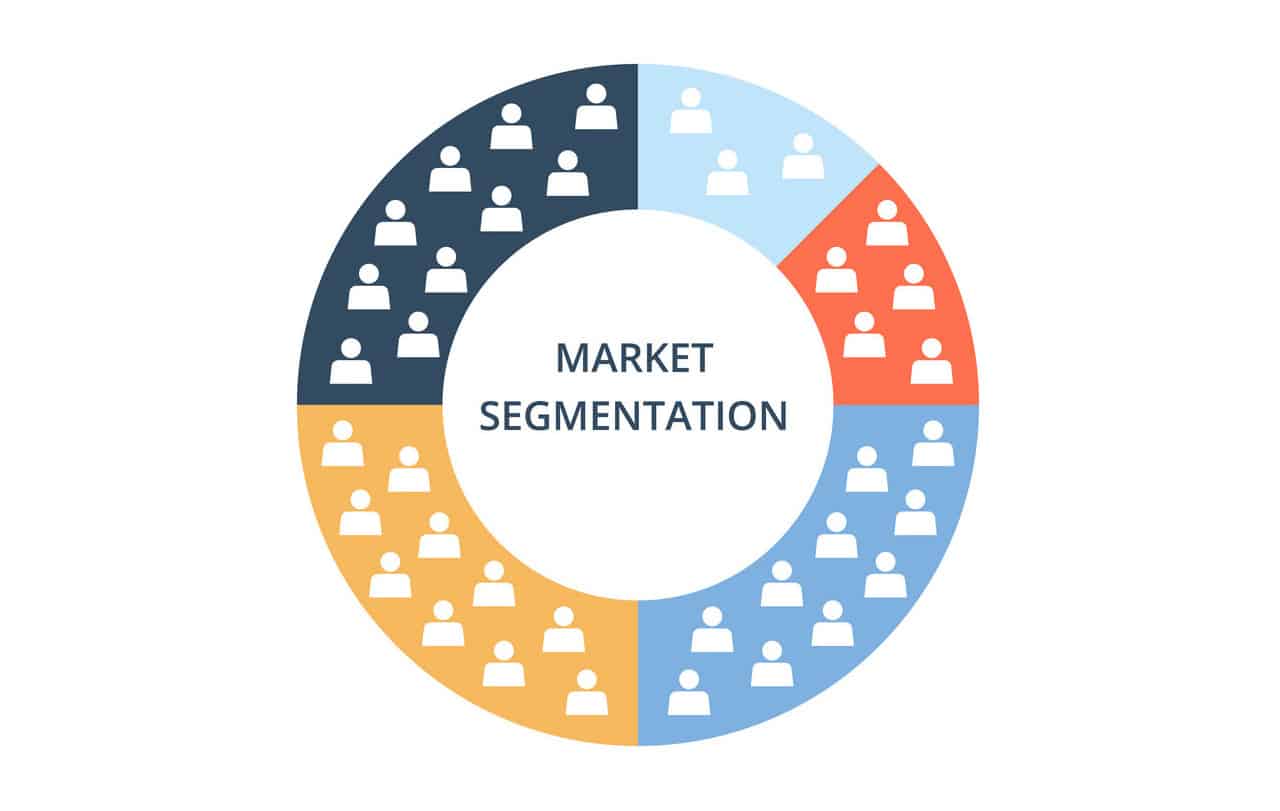So, lots of people have been given business tips on how to segment the target market. Some have even given the wrong tips. However, we have simplified and detailed information about market segmentation. Also included here are the best market segmentation types and bases, and its possible benefits of market segmentation. Stay with us!
What Is Market Segmentation
The key to conducting an effective marketing campaign for a particular product or service is by identifying consumers who share a common need for this product or service inside the targeted market.
Market segmentation is therefore a marketing strategy that involves segmenting or grouping potential consumers in a target market who share homogeneous characteristics. The essence of this is thus to enable marketers to channel only the necessary marketing campaign to the focus group.
BASES OF MARKET SEGMENTATION
Segmentation means dividing a group into separate parts or sections. These parts or sections hang on the following categories/bases of market segmentation which are; gender, income, age grade, location, occupation, usage, and lifestyle.
#1. Gender
This is one of the main bases for market segmentation. The interests and likes of the male and female gender differences, and so does their wants and needs.
Bearing this in mind, marketers will be able to focus a campaign on the right gender.
For example, marketing strategies for jewelry, cosmetics, and high-end clothes focus on the female gender. On the other hand, one for video games and soccer jerseys focuses on the males for better conversion.
#2. AGE GRADE
Segmenting the market based on age grade can help marketers identify what is obtainable when making marketing decisions.
As our ages are different, so as our wants and needs are different. What a teenager needs are quite different from what a toddler needs.
This helps marketers to know, identity, and create marketing strategies that target the specific need of each age grade within the target market for better conversion.
For example, a fashion company introducing high-grade sneakers into the market must first identify the particular age group that wears sneakers and channel their marketing to them. Instead of just assuming that everybody in the target market wears sneakers.
#3. INCOME
Our income decides our purchasing power. Segmenting the market based on income power will help identify the high-income earners, mid-income earners, and low-income earners.
Marketing activities of luxury items resonate with everybody in the target market. Instead, they resonante with the highest income earners.
#4. PLACE
Marketing ads are primarily sent to urban cities.
Segmenting the market with the location as a factor will help identify those places where the items will be in high demand and direct more marketing strength.
A fashion company will send more marketing ads to urban cities than to underdeveloped areas with little or no access to basic amenities.
#5. OCCUPATION
Our occupation determines our earning power. Just like the income, it determines how much we can afford.
So, by this particular bases of market segmentation, the market based on occupation will help guide marketers to make informed decisions when it comes to pushing marketing ads to customers
#6. USAGE
How often we use a particular product or service can also play a significant role in determining marketing strategies for marketers.
Dividing the target market the volume of usage in mind will help show marketers where a product is in great demand. Sometimes it can also influence marketers to reward prices to those customers who they know are heavy users of that particular product.
TYPES OF MARKET SEGMENTATION
The following are the types of market segmentation, they include;
- Geographic Segmentation
- Demographic segmentation
- Psychographic Segmentation
- Behavioral Segmentation
- Firmographic Segmentation
#1. GEOGRAPHIC SEGMENTATION
This type of segmentation divides the market based on geography; the study of the earth. Studying the locations of the earth helps marketers to identify the uniqueness of each place, the people, the culture, the environment, and the weather. It will help marketers to recognize that what is available and abundant in one region of the earth is also not available and scarce in another area.
Consider a company that sells sweatshirts, which is mostly worn in areas with extremely cold weather and climate. They’re likely to make more sales in this region than selling in a place with a hot and temperate climate, which will not bring back great returns on their investments. Geographic segmentation helps marketers create strategies that are personalized for each region.
#2. DEMOGRAPHIC SEGMENTATION
This type of segmentation divides the market based on variables like age, gender, culture, religion, race, occupation, etc. This is one of the most common segmentation marketers use in creating marketing plans. It is assumed that customers’ buying behavior is influenced by their demographic. For example, a customer who sees nothing wrong in wearing makeup will buy a makeup kit and other fashion items. While the one that has some reservations about makeup will not only not buy a makeup kit, but also avoid products that are similar to it.
#3. PSYCHOGRAPHIC SEGMENTATION
This segmentation divides the market based on their lifestyle, attitude to life, personality. A person’s attitude, lifestyle, and personality greatly affect his buying decisions to a great extent.
A person who lives lavishly might consider buying a private jet as a need, while another person within the same city but lives a conservative lifestyle will see it as a luxury and unnecessary.
#4. BEHAVIOURAL SEGMENTATION.
Behavioral segmentation targets customer’s choices, decision making, preference, etc. This segment is divided based on the frequent use of the product and knowledge about it. It identifies who the loyal and repeat customers are, the neutral customers, the undecided customers, first-time customers, and the potential customers. This attributes how Google dominates the market.
see Also: How Google dominates the market
The buying frequency differs under this segment, making marketers send a strategic marketing campaign to further entice the new and existing customers to become loyal to the product.
#5. FIRMOGRAPHIC SEGMENTATION
Firmographics are used to describe the attributes of a business, based on its scale, size, and funding. Firmographics are what the customers are in demographics. In other words, the segments we identify and analyze under demographics are what the size, scale, and funding are to Firmographics.
It helps show whether an organization is fit for investment, highlighting the pros and cons of going into business with such a company.
See Also: 7 Effective Brand Marketing Techniques
BENEFITS OF MARKET SEGMENTATION
The following outlines the benefits of market segmentation
#1. Increased Market Share
This is one of the major benefits of market segmentation. Through proper segmentation and targeted ads, this, in turn, increases the market share of the company. It also helps firms identify the best possible ways to further deepen and widen the range of its marketing strategies.
#2. Customer Retention
Proper market segmentation helps improve and increase customer retention. By identifying and personalizing marketing information to the targeted customers, it portrays to the customers that the organization understands their needs and requirements.
Read Also: 15 Best easy customer retention strategies for sustaining revenue
#3. Increased Revenues
Proper market segmentation will also increase revenues for the company. Instead of wasting money on non-targeted marketing, which is also a waste of resources as it increases costs while sales decreases. This is also one of the major benefits of market segmentation
#4. Better Knowledge Of Customer Needs
The right segmentation will only identify and reveal the needs of customers to the organization. By engaging in proper market segmentation, it helps the organization to match appropriate products to the approximate customers who need them.
#5. Identify Gaps In The Market
Conducting proper market segmentation can help organizations identify some major or minor gaps in the market. This will either open up opportunities for organizations to exploit or it will help them close up areas where they haven’t been effective or oblivious to.
#6. Better Opportunity For Growth
Market segmentation offers organizations the opportunity to improve on their services. It helps them track there progress in the market, by revealing areas that need to be improved upon.
See Also: Best Affiliate Marketing Guide to Earn With
BEST MARKET SEGMENTATION EXAMPLES
Sports: Big sports brands like Adidas, Nike, Puma, Reebok, Joma, etc often send out targeted marketing campaigns. These are to sports clubs, players, athletes, fans, supporters, etc bases on the type of sports being played.
Fashion Houses: Big fashion brands like Fendi, Versace, Zara, etc designs and sends out a targeted marketing campaign to customers based on their demographics; gender, age, income, lifestyle, location, etc.
Aviation: Big airline companies segment their target market according to the buying power of their customers. Premium offers are targeted to those customers who reside in areas where there are high-income earners. While mid-income earners have offers that suit their demands.
Service Industries: Mobile telecommunication giant like MTN, segments their customers based on their income level. This is done by monitoring the volume of transactions within a particular time by each customer. Some customers enjoy postpaid services, while some enjoy prepaid services based on their capacity to use the service.
What Is the Division of the Market?
Companies utilize market segmentation as a method to divide up their potential clients into distinct groups. This makes it possible for the business to give the proper resources to each distinct segment, enabling more precise targeting across a range of marketing efforts.
What Are the Advantages of Market Segmentation?
It involves breaking up the target market into more manageable segments. Companies can better grasp their target market thanks to these segments. Similar traits like hobbies, needs, geography, demographics, priorities, and personality factors can be used to segment them.
What Is the Primary Intent Behind Segmentation?
Segmentation is used to focus marketing efforts on the customers that fit your ideal customer profile (ICP), or those who are most likely to purchase your good or service.
Which Market Segmentation Strategies Are Used?
The best way to reach your target market is to establish which clients you can develop connections with, how to categorize them, and what marketing initiatives to implement using a marketing segmentation plan. Providing customers with a tailored experience results in improved customer retention rates and more targeted marketing strategies.
What Foundations Do Market Segmentation Rely On?
Segmentation bases can be divided into three categories. Before choosing the best for your needs, it’s important to weigh your selections because each works well with certain businesses and industries. Demographic, psychographic, and behavioral market segmentation are the three basic categories.
What are the 4 types of market segmentation?
The following are the types of market segmentation, they include;
- Geographic Segmentation
- Demographic segmentation
- Psychographic Segmentation
- Behavioral Segmentation
- Firmographic Segmentation
What are the benefits of market segmentation?
The following outlines the benefits of market segmentation
- #1. Increased Market Share
- #2. Customer Retention
- #3. Increased Revenues
- #4. Better Knowledge Of Customer Needs
- #5. Identify Gaps In The Market
How do you identify market segments?
In order to be a good market segment: (or differentiable). It should be possible to describe a group of people based on their descriptive characteristics or how they act.






